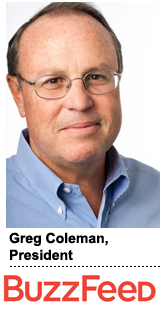 “Remember, I’m on day five,” Greg Coleman said on Friday. The former president of Criteo, which went public earlier this year, recently hopped aboard BuzzFeed, where he’ll serve as president and on the board of directors. The switch reunites Coleman with many of his old co-workers at Huffington Post, including BuzzFeed CEO Jonah Peretti.
“Remember, I’m on day five,” Greg Coleman said on Friday. The former president of Criteo, which went public earlier this year, recently hopped aboard BuzzFeed, where he’ll serve as president and on the board of directors. The switch reunites Coleman with many of his old co-workers at Huffington Post, including BuzzFeed CEO Jonah Peretti.
Shortly after the hire, BuzzFeed raised $50 million from Andreessen Horowitz. Among other things, the money will help fund BuzzFeed’s nascent video business. Figuring out how to best organize sales for this video business will be part of Coleman’s job.
Also on the table is international expansion. “Today we have a large operation in London, and a smaller one in Germany and Australia. Part of my mandate from Jonah and the board is to go through the diagnostics around what countries we should be in, and how should we fund them (either alone or with a joint venture). This company has global legs, and we need to find countries that love what we do,” Coleman said.
Since his hire, he’s had a barrage of emails, and tweets congratulating him on his move. For someone that’s usually gone against the grain in his job choices, that makes him a little nervous. “When I left Reader’s Digest for Yahoo, right after the dot-com crash and the Internet blew up, everyone thought I was crazy. When I joined Huffington Post, everyone said, ‘Why are you joining this left-wing political blog?’ When I joined Criteo, everyone told me, ‘Why are you joining this company no one’s heard of?’ Then we took it public. So I’m a little nervous because everyone is saying this is a no-brainer, when everyone’s challenged my previous moves.”
On Friday, Coleman talked with AdExchanger about his hire, selling native advertising, and what’s ahead for the media company that turned down an offer to be acquired by Walt Disney.AdExchanger: How did you get matched up with BuzzFeed?
GREG COLEMAN: The team here at BuzzFeed is to a large degree the founding team of the Huffington Post. Ken Lerer and Jonah Peretti [who co-founded The Huffington Post] called to meet with me, and after a bit of chit-chat they said they would like for me to come back to the family.
My jaw dropped, and inside I said, “Holy mackerel!” I didn’t expect this, and I’m probably going to do this. When [BuzzFeed president] Jon Steinberg left, it didn’t even dawn on me to talk to the team. But when the words came out of their mouth, it was such a natural thing it blew my mind for the week. So we did the deal, and now it’s my fifth day on the job.
Criteo is all about programmatic advertising. How might that skillset transfer to BuzzFeed?
At BuzzFeed, we currently are not doing any form of programmatic, because we do not accept banner ads, and everything we do is native. For sure we are going to explore it, and I literally have no idea what we are going to find. Let’s say we decided to work something out with Criteo that’s without banner ads. It’s not obvious what the solution is. Out of fifteen-some initiatives, programmatic will be one of them. We’re going to see if we can find a heartbeat.
What other initiatives are going to be a priority for you?
BuzzFeed has grown so fast in the last four years since it really launched, so at this point it’s about the building blocks of having this rocket ship continue over the next two years and get to the next step. We have to look at organization as a whole, and how teams are working together.
We will be look at things like how we package and price our programs to marketers. Jonah is going to be responsible for editorial and technology, and I’m responsible for the rest of the business.
The world of video is going to be gigantic. Video has the chance to be larger than the Buzzfeed.com site. Under Ze Frank, the team in LA is completely rethinking short-form video, and BuzzFeed Motion Pictures was created for ideas in long-form video. Understanding how video is going to play a role in the business of BuzzFeed is going to be a key thing we’re going to be figuring out.
How might you sell video? Other media companies have explored this idea of selling video advertising online and on television coming out of one budget. Is that the kind of model you might go for?
This will be a good conversation for us to have in another month or two. When you have a new different channel like video, it’s first things first, build out that content, and the sponsored videos, and then collaborate internally on what’s the best way to organize.
We’ll be thinking through the impact on the sales side, questions like whether we do it blended or do it separately. I don’t have is the answers around how that integration is going to work, and that will be part of the fun, to brainstorm and think it through.
What about measuring performance of BuzzFeed’s native placements?
At Criteo, everything we did was measured with an electron microscope. Similarly here at BuzzFeed, we need to provide real analytics about what happens when someone views a native ad. We’re going to do research about measuring the impact of our native campaigns.
Already, advertisers can look at the CPM they’re paying, just like a regular site, but what makes us difference is CPV, or cost per view, which takes into account how many people see the post through a share, and the number of people sharing these sponsored posts is incredible. When people are reading a story about Pepsi and share with a friend, that not only backs into a CPV, but my own point-of-view is that if a friend of mine shares a post with me about Pepsi, that’s way more important than finding it on your own. We’ll be trying to understand the value of the media that’s shared, and how that goes into overall presentation and pricing.
In a lot of the media surrounding your funding announcement, there’s been this idea of BuzzFeed being a technology company, not a media company. What does that mean to you?
The average person would look at BuzzFeed, and say, “Wow, at this interesting content, I like it and I’m going to share with my friend.” What’s under the hood is a massive technological infrastructure. It’s not by luck that those people say the quiz is amazing. It’s more complicated, and there is this technology that makes BuzzFeed realize what will make them want to share.
What’s different about running a digital publication in the age of The Huffington Post compared to the age of BuzzFeed?
When I went to The Huffington Post, all we did was digital, and it gave us a massive advantage in that we didn’t have to protect any of our analog readers or ad dollars. It’s like if you were trying to learn Chinese. If you went into classes you’d learn a bit, but if you were parachuted into China, you’re really going to learn it, because it’s all that you’ve got. That’s why Huffington Post grew and that’s why BuzzFeed is tearing it up.
I remember at the Huffington Post, we had the team at the New York Times laughing at us and dismissing us. A year after we got there, we were 50% the size of The New York Times, and before they knew it, were as big as them, and then we were 50% larger than they were. They never saw us coming.
Jonah Peretti is wildly smart, and gets this idea of contagious marketing and what makes people want to share. Now we have 150 million unique visitors monthly. The understanding of social and native has accelerated. We take no display ads. It’s 100% native, which was Jonah’s idea a few years ago. I was an adviser at BuzzFeed, and when he told me he was not going to have any display ads, I couldn’t believe it. And he was right. It’s created an editorial view and a user experience that allows you to go much deeper into the content, and changes the partnering that can be done with advertisers.













